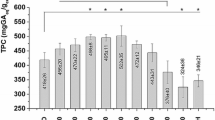Abstract
Utilization of renewable resources is gaining more emphasis and large quantities of solid wastes are produced by the forestry industry. However, there is a significant lack of transformation of such wastes into potentially novel products. The barks of various Pinus species from different regions of Turkey (P. pinea, P. sylvestris, P. nigra) and Germany (P. parviflora, P. ponderosa, P. sylvestris, P. nigra) were extracted by supercritical CO2 extraction. Different sources of variability including location and species were evaluated for their active constituents, (−)-catechin, (−)-epiatechin, (−)-catechin gallate, and taxifolin, applying HPLC, radical scavenging activities (RSA), and total phenol analysis. The total amounts of flavan-3-ols (9.916 mg/g) were the highest in P. pinea extract harvested from Aydin, having the hottest climate and longest duration of sun (P < 0.01). In addition, P. pinea had the highest RSA (81.0 %) and total phenol value (83.0 mg GAE/g).




Similar content being viewed by others
References
Turley DB, Chaudhry Q, Watkins RW, Clark JH, Deswarte FEI (2006) Ind Crops Prod 24(3):238–243
Zulaica-Villagomez H, Peterson DM, Herrin L, Young RA (2005) Holzforschung 59(2):156–162
Selga A, Torres JL (2005) J Agric Food Chem 53(20):7760–7765
Cui YY, Xie H, Wang JF (2005) Phytother Res 19(1):34–38
Jung MJ, Chung Y, Choi JH, Choi JS (2003) Phytother Res 17(9):1064–1068
Saleem A, Kivela H, Pihlaja K (2003) Z Naturforsch C 58(5–6):351–354
Hertog MGL (1996) Proc Nutr Soc 55(1B):385–397
Romani A, Ieri F, Turchetti B, Mulinacci N, Vincieri FF, Buzzini P (2006) J Pharma Biomed Anal 41(2):415–420
Sarikaki V, Rallis M, Tanojo H, Panteri I, Dotsikas Y, Loukas YL, Papaioannou G, Demetzos C, Weber S, Moini H, Maibach HI, Packer L (2004) J Toxic Cutaneous Ocul Toxic 23(3):149–158
Rohdewald P (2002) Int J Clin Pharmacol Ther 40(4):158–168
Packer L, Rimbach G, Virgili F (1999) Free Radic Biol Med 27(5-6):704–724
Jerez M, Selga A, Sineiro J, Torres JL, Nunez MJ (2007) Food Chem 100(2):439–444
Jerez M, Tourino S, Sineiro J, Torres JL, Nunez MJ (2007) Food Chem 104(2):518–527
Yu L, Zhao M, Wang JS, Yang B, Jiang Y, Zhao Q (2008) Innov Food Sci Emerg Technol 9(1):122–128
Guri A, Kefalas P, Roussis V (2006) Phytother Res 20(4):263–266
Hsu TY, Sheu SC, Liaw ET, Wang TC, Lin CC (2005) Phytomedicine 12(9):663–669
Perva-Uzunalic A, Skerget M, Knez Z, Otto F, Gruner S (2006) Food Chem 96(4):597–605
Ritter DC, Campbell AG (1991) Wood Fiber Sci 23(1):98–113
Braga MEM, Santos RMS, Seabra IJ, Facanali R, Marques MOM, de Sousa HC (2008) J Supercrit Fluids 47(1):37–48
Yesil-Celiktas O, Otto F, Gruener S, Parlar H (2009) J Agric Food Chem 57:341–347
Yesil-Celiktas O, Girgin G, Orhan H, Wichers HJ, Bedir E, Vardar-Sukan F (2007) Eur Food Res Technol 224:443–451
Karonen M, Loponen J, Ossipov V, Pihlaja K (2004) Anal Chim Acta 522(1):105–112
Turkish State Meteorological Service (2008) Climatic data between 1975 and 2006. http://www.meteor.gov.tr
AGES – Gesellschaft für Energieplanung und Systemanalyse m. b. H. (2008) Climatic data between 1975 and 2008. http://klimadaten.ages-gmbh.de
Elvira S, Alonso R, Castillo FJ, Gimeno BS (1998) New Phytol 138:419–432
Yesil-Celiktas O, Bedir E, Vardar-Sukan F (2007) Food Chem 101:1457–1464
Acknowledgments
The postdoctoral research grant provided by TUBITAK-BIDEB for performing this research is gratefully acknowledged.
Author information
Authors and Affiliations
Corresponding author
Rights and permissions
About this article
Cite this article
Yesil-Celiktas, O., Otto, F. & Parlar, H. A comparative study of flavonoid contents and antioxidant activities of supercritical CO2 extracted pine barks grown in different regions of Turkey and Germany. Eur Food Res Technol 229, 671–677 (2009). https://doi.org/10.1007/s00217-009-1101-5
Received:
Revised:
Accepted:
Published:
Issue Date:
DOI: https://doi.org/10.1007/s00217-009-1101-5




